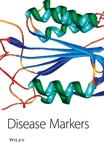Prognostic Role of microRNA-155 in Various Carcinomas: Results from a Meta-Analysis
Abstract
BACKGROUND: Recent studies have shown that microRNAs (miRNA) have prognostic values in cancers. This meta-analysis seeks to summarize the global predicting role of miR-155 for survival in patients with a variety of carcinomas.
METHODS: Eligible studies were identified through multiple search strategies. Data were extracted from studies investigating the relationship between miR-155 expression and survival in cancer patients. Combined hazard ratios (HRs) of miR-155 for outcome were analyzed.
RESULTS: A total of 16 studies dealing with various carcinomas were included for this meta-analysis. For overall survival, higher miR-155 expression could significantly predict worse outcome with the pooled HR of 2.057 (95% CI: 1.392–3.039). For relapse or progress-free survival, elevated miR-155 was also a significant predictor, with a combined HR of 1.918 (95% CI: 1.311–2.806,). In addition, subgroup analysis showed that higher expression of miR-155 had the trends to predict worse outcome in lung cancer. However, the HRs did not reach the statistical significance.
CONCLUSION: Our findings suggest that miR-155 detection has a prognostic value in cancer patients. Regularly measuring miR-155 expression may be useful in clinical practice.




